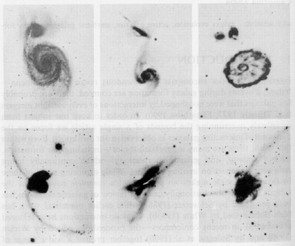Our galaxy, the Milky Way, is currently crashing into at least two other galaxies: the Canis Major dwarf galaxy and the Sagittarius dwarf galaxy. Since they are dwarf galaxies, the Milky Way is 'winning' by eating them up. There are some good illustrations of how the Milky Way is tearing the Canis Major galaxy apart here. This also means that these galaxies are the closest to us.
It turns out that galactic collisions are more common than was once thought. Since galaxies carry a fair bit of mass, it makes sense that a lot of them might be gravitationally bound to each other. And some of them will eventually collide. The interesting part is that stars are so small compared to the galactic scale that actual star-star collisions are probably quite rare, even when the galactic centers pass close to each other, as in the well-known Cartwheel Galaxy, which shows the gravitational shock-wave, or splash made by the collision:

Other collision geometries and times result in many different shapes, as seen in negatives here:

Where the Cartwheel galaxy is the top right. The one that always strikes me is the bottom left, known as the Antennae. The long arms strung out from the centers are billions of stars, ejected from the galaxies - along with any planets and intelligent life they might have. What I wonder about is the psychological impact that that kind of realization must have on a civilization. Can you imagine finding out that you are in the midst of being ejected from your galaxy, and that any possibility of traveling to other stars is getting more and more remote by the second?
The good news for us is that we are still firmly ensconced in our arm of the Milky Way, with time to find a way to travel even to the nearest star. The bad news is that there is a much bigger crash headed our way at 500,000 km/hr. No need to worry just yet, because first contact with the Andromeda Galaxy is about 3 billion years away.
Here (10Mb file!) is a movie of the collision, showing the spectacularly haunting interplay that flings billions of suns into darkness. Including, possibly, our own.